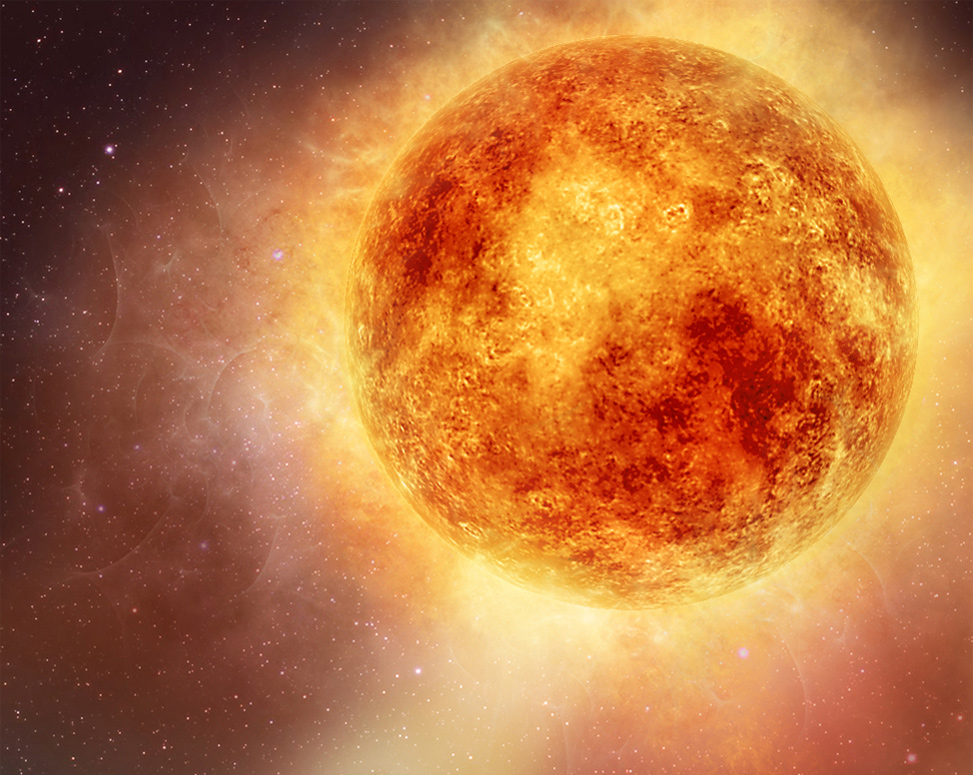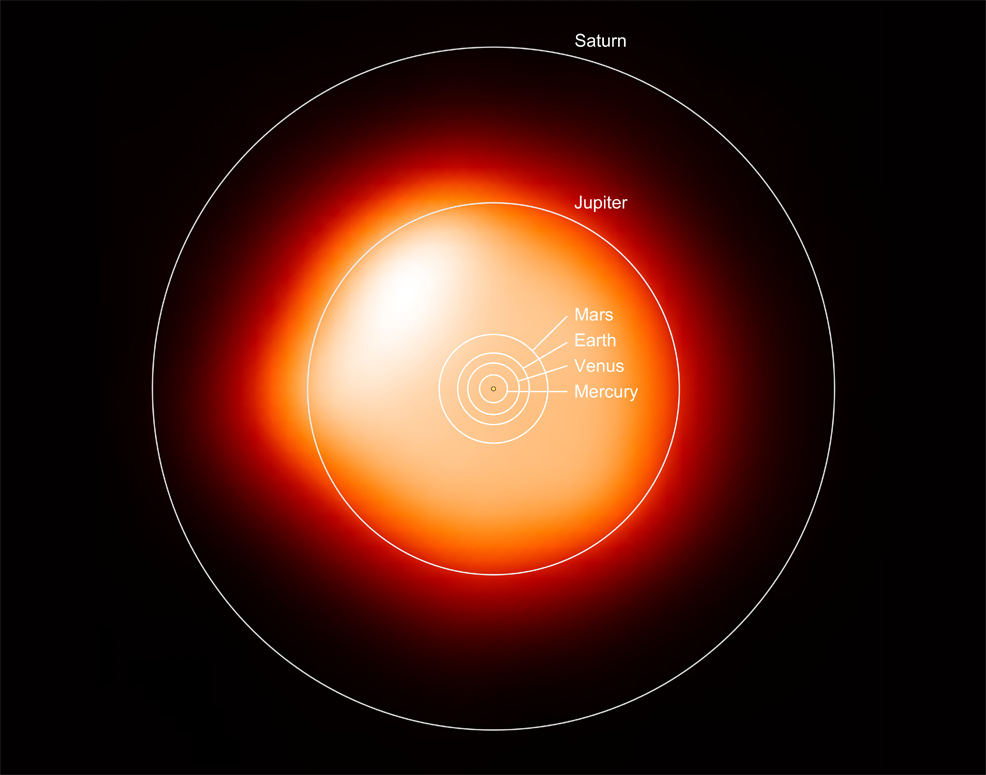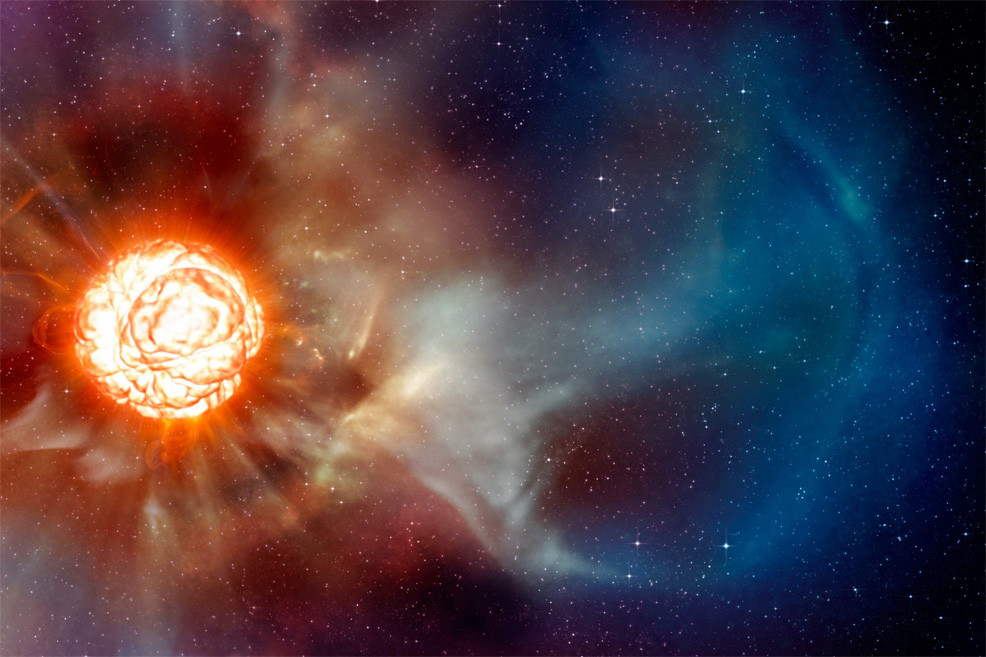
23rd October 2020 Betelgeuse is smaller and closer than previously thought A new study finds that the red supergiant Betelgeuse is 530 light years away, about 25% closer than previously thought. Additionally, its size has been revised downwards.
Betelgeuse is arguably the most famous of all the red supergiant stars in our galaxy. It appears prominently in the night sky as the tenth brightest star and – after Rigel – the second brightest in the constellation of Orion. Less than 10 million years old, Betelgeuse evolved rapidly because of its huge mass and is expected to end its lifetime with a supernova explosion, most likely within 100,000 years (the blink of an eye, in astronomical terms). In 1920, Betelgeuse became the first star outside our Solar System to have the angular size of its photosphere measured, with an estimated diameter of 384,000,000 km (2.58 AU). In more recent decades, improvements in telescopic imaging have revealed new insights into this monster star, dramatically revising its size upward. Advances in the 1970s helped to reduce the blurring and twinkling effect of stars caused by turbulence in Earth's atmosphere, allowing for more precise measurements of Betelgeuse and its photosphere. During the late 1980s and early 1990s, breakthroughs occurred in both visible-light and infrared imaging – revealing asymmetry as well as bright spots on the surface. A major boost in resolution became possible when the Hubble Space Telescope, superior to ground-based interferometers, observed Betelgeuse at ultraviolet (UV) wavelengths. This generated the first direct image of the disk of a star other than our own Sun. The Atacama Large Millimeter/submillimeter Array (ALMA) in northern Chile – which began observations in 2011 and is the most expensive ground-based telescope in operation – released the following image in 2017, which includes our Solar System to scale.
However, a new study by an international team of astronomers suggests that Betelgeuse may not be quite so huge after all. Led by Dr Meridith Joyce from the Australian National University (ANU), this new research shows that Betelgeuse is both smaller and closer to Earth than previously thought. "It's normally one of the brightest stars in the sky, but we've observed two drops in the brightness of Betelgeuse since late 2019," Dr Joyce said. "This prompted speculation it could be about to explode. But our study offers a different explanation. We know the first dimming event involved a dust cloud. We found the second smaller event was likely due to the pulsations of the star." Her team used hydrodynamic and seismic modelling to learn more about the physics driving these strange pulsations – and to get a clearer idea of what phase of its life Betelgeuse is in. According to co-author Dr Shing-Chi Leung from the University of Tokyo, the new analysis "confirmed that pressure waves – essentially, sound waves – were the cause of Betelgeuse's pulsation." This new modelling enabled more precise calculations of the star's characteristics, narrowing down both its size and distance from Earth. It also provided proof that a supernova event is unlikely anytime soon. "The actual, physical size of Betelgeuse has been a bit of a mystery – earlier studies suggested it could be bigger than the orbit of Jupiter," said co-author Dr László Molnár from the Konkoly Observatory in Budapest. "Our results say Betelgeuse only extends out to two-thirds of that, with a radius 750 times the radius of the Sun. Once we had the physical size of the star, we were able to determine the distance. Our results show that it's 530 light years from Earth – about 25% closer than previous thought." "It's burning helium in its core at the moment, which means it's nowhere near exploding," Dr Joyce explained. "We could be looking at around 100,000 years before an explosion happens." The good news is that, despite being a lot closer than previously thought, Betelgeuse is still too far from Earth for the eventual explosion to have a significant impact here. The event will nevertheless be spectacular – bright enough to be seen during daylight hours on Earth, should any of our descendants still be around by then to view it.
--- Follow us: Twitter | Facebook | Instagram | YouTube
Comments »
If you enjoyed this article, please consider sharing it:
|









